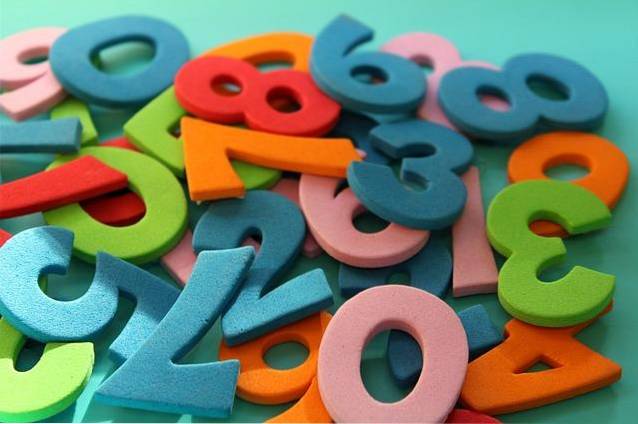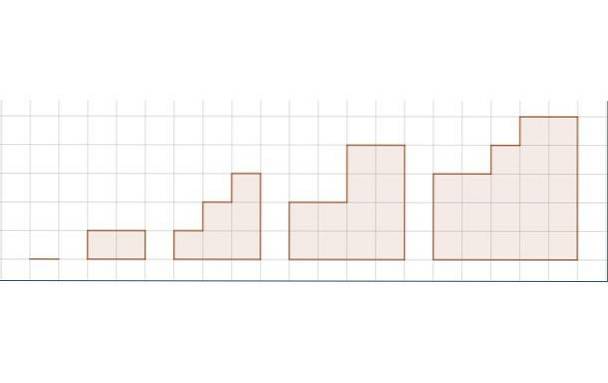
Quadratic sequences examples, rule and solved exercises
The quadratic sequences, in mathematical terms, they consist of sequences of numbers that follow a certain arithmetic rule. It is interesting to know this rule to determine any of the terms of a sequence.
One way to do this is to determine the difference between two successive terms and see if the value obtained is always repeated. When this is the case, it is said to be a regular succession.

But if it does not repeat itself, then you can try to examine the difference between differences and see if this value is constant. If so, then it is a quadratic sequence.
Article index
- 1 Examples of regular sequences and quadratic sequences
- 1.1 Example of regular succession
- 1.2 Example of non-regular and quadratic sequence
- 2 General rule for constructing a quadratic sequence
- 2.1 Difference between two consecutive terms of a quadratic sequence
- 3 Solved problems of quadratic sequences
- 3.1 Exercise 1
- 3.2 Exercise 2
- 3.3 Exercise 3
- 4 References
Examples of regular sequences and quadratic sequences
The following examples help clarify what has been explained so far:
Example of regular succession
Let the sequence S = 4, 7, 10, 13, 16,…
This sequence, denoted by S, is an infinite numerical set, in this case of integers.
It can be seen that it is a regular sequence, because each term is obtained by adding 3 to the previous term or element:
4
4 +3 = 7
7+3 = 10
10+3 = 13
13+3 = 16
In other words: this sequence is regular because the difference between the next term and the previous one gives a fixed value. In the given example this value is 3.
The regular sequences that are obtained by adding a fixed quantity to the previous term are also called arithmetic progressions. And the difference -constant- between successive terms is called reason and is denoted as R.
Example of non-regular and quadratic sequence
See now the following sequence:
S = 2, 6, 12, 20, 30,….
When successive differences are calculated, the following values are obtained:
6-2 = 4
12-6 = 6
20-12 = 8
30-20 = 10
Their differences are not constant, so it can be said that it is a NOT regular sequence.
However, if we consider the set of differences, we have another sequence, which will be denoted as Sdiff:
Sdiff = 4, 6, 8, 10,….
This new succession is a regular succession, since each term is obtained by adding the fixed value R = 2 to the previous one. Therefore we can affirm that S is quadratic sequence.
General rule for constructing a quadratic sequence
There is a general formula to construct a quadratic sequence:
Tn = A ∙ ntwo + B ∙ n + C
In this formula, Tn is the term of position n of the sequence. A, B and C are fixed values, while n varies one by one, that is, 1, 2, 3, 4, ...
In the sequence S of the previous example A = 1, B = 1 and C = 0. From there it follows that the formula that generates all the terms is: Tn = ntwo + n
Namely:
T1 = 1two + 1 = 2
Ttwo = 2two + 2 = 6
T3 = 3two + 3 = 12
T5 = 5two + 5 = 30
Tn = ntwo + n
Difference between two consecutive terms of a quadratic sequence
Tn + 1 - Tn = [A ∙ (n + 1)two + B ∙ (n + 1) + C] - [A ∙ ntwo + B ∙ n + C]
Developing the expression through remarkable product remains:
Tn + 1 - Tn = A ∙ ntwo + A ∙ 2 ∙ n + A + B ∙ n + B + C - A ∙ ntwo - B ∙ n - C
By simplifying it, you get:
Tn + 1 - Tn = 2 ∙ A ∙ n + A + B
This is the formula that gives the sequence of differences SDif which can be written like this:
Difn = A ∙ (2n + 1) + B
Where clearly the next term is 2 ∙ Sometimes the previous one. That is, the ratio of the sequence of differences Sdiff is: R = 2 ∙ A.
Solved problems of quadratic sequences
Exercise 1
Let the sequence S = 1, 3, 7, 13, 21,…. Determine if:
i) Is it regular or not
ii) Is it quadratic or not
iii) It was quadratic, the sequence of differences and their ratio
Answers
i) Let's calculate the difference between the following and the previous terms:
3-1 = 2
7-3 = 4
13-7 = 6
21-13 = 8
We can affirm that the sequence S is not regular, because the difference between successive terms is not constant.
ii) The sequence of differences is regular, because the difference between its terms is the constant value 2. Therefore the original sequence S is quadratic.
iii) We have already determined that S is quadratic, the sequence of the differences is:
Sdiff = 2, 4, 6, 8, ... and its ratio is R = 2.
Exercise 2
Let the sequence S = 1, 3, 7, 13, 21,… from the previous example, where it was verified that it is quadratic. Determine:
i) The formula that determines the general term Tn .
ii) Check the third and fifth terms.
iii) The value of the tenth term.
Answers
i) The general formula of Tn is A ∙ ntwo + B ∙ n + C. Then it remains to know the values of A, B and C.
The sequence of differences has ratio 2. Furthermore, for any quadratic sequence the ratio R is 2 ∙ A as shown in the previous sections.
R = 2 ∙ A = 2 which leads us to conclude that A = 1.
The first term of the sequence of differences SDif is 2 and must satisfy A ∙ (2n + 1) + B, with n = 1 and A = 1, that is:
2 = 1 ∙ (2 ∙ 1 + 1) + B
solving for B, we obtain: B = -1
Then the first term of S (n = 1) is worth 1, that is: 1 = A ∙ 1two + B ∙ 1 + C. As we already know that A = 1 and B = -1, substituting we have:
1 = 1 ∙ 1two + (-1) ∙ 1 + C
Solving for C we obtain its value: C = 1.
In summary:
A = 1, B = -1 and C = 1
Then the nth term will be Tn = ntwo - n + 1
ii) The third term T3 = 3two - 3 + 1 = 7 and it is verified. The fifth T5 = 5two - 5 + 1 = 21 which is also verified.
iii) The tenth term will be T10 = 10two - 10 + 1 = 91.
Exercise 3

The figure shows a sequence of five figures. The lattice represents the unit of length.
i) Determine the sequence for the area of the figures.
ii) Show that it is a quadratic sequence.
iii) Find the area of figure # 10 (not shown).
Answers
i) The sequence S corresponding to the area of the sequence of figures is:
S = 0, 2, 6, 12, 20,…
ii) The sequence corresponding to the consecutive differences of the terms of S is:
Sdiff = 2, 4, 6, 8,…
Since the difference between consecutive terms is not constant, then S is not a regular sequence. It remains to know if it is quadratic, for which we again do the sequence of the differences, obtaining:
2, 2, 2,….
Since all the terms of the sequence are repeated, it is confirmed that S is a quadratic sequence.
iii) The sequence Sdiff is regular and its ratio R is 2. Using the equation shown above R = 2 ∙ A, it remains:
2 = 2 ∙ A, which implies that A = 1.
The second term of the sequence of differences SDif is 4 and the nth term of SDif it is
A ∙ (2n + 1) + B.
The second term has n = 2. In addition, it has already been determined that A = 1, so using the previous equation and substituting, we have:
4 = 1 ∙ (2 ∙ 2 + 1) + B
Solving for B we obtain: B = -1.
It is known that the second term of S is worth 2, and that it must fulfill the formula of the general term with n = 2:
Tn = A ∙ ntwo + B * n + C; n = 2; A = 1; B = -1; Ttwo = 2
Namely
2 = 1 ∙ 2two - 1 ∙ 2 + C
It is concluded that C = 0, that is to say that the formula that gives the general term of the sequence S is:
Tn = 1 ∙ ntwo - 1 ∙ n +0 = ntwo - n
Now the fifth term is verified:
T5 = 5two - 5 = 20
iii) Figure # 10, which has not been drawn here, will have the area corresponding to the tenth term of the sequence S:
T10 = 10two - 10 = 90
References
- https://www.geogebra.org



Yet No Comments